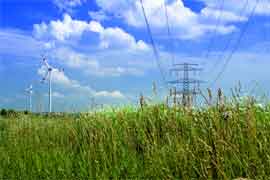The research project “NEST-DC” aims to investigate the foundations of an innovative semiconductor-based and completely electronic circuit breaker for DC power grids and applications.
 Neubiberg, Germany – July 1, 2014 – Direct current offers many advantages compared to the conventional alternating current used today: For example, losses in power grids and electric devices area total of 5to7 percent smaller than with alternating current. Direct current also makes it possible to more efficiently feed electric energy from regenerative sources into power grids and energy storage and to improve grid stability; with direct current it would be possible to build much more compact electric devices.
Neubiberg, Germany – July 1, 2014 – Direct current offers many advantages compared to the conventional alternating current used today: For example, losses in power grids and electric devices area total of 5to7 percent smaller than with alternating current. Direct current also makes it possible to more efficiently feed electric energy from regenerative sources into power grids and energy storage and to improve grid stability; with direct current it would be possible to build much more compact electric devices.
In the past the lack of efficient and cost-effective circuit breaker technologies has made it impossible to fully exploit the potentials of direct current, e.g. in distribution grids in data center, photovoltaics and telecommunication systems or in on board grids for aviation and shipping, electric vehicles and railway technology. The only electromechanical circuit breakers available today implicate the risk of arcing when switching direct current and voltages; furthermore they are slow to react, heavy, unwieldy and expensive.
Funded by the German Federal Ministry of Education and Research (BMBF), theresearch project “NEST-DC” aims to investigate the foundations of an innovativesemiconductor-based and completely electronic circuit breaker for DC power grids and applications. The new circuit breaker should be able to switch direct current on, and most importantly switch it off, as quickly and safely as possible at voltages ofupto 1,500V. Among other things NEST-DC will explore innovative semiconductor componentssuch as the Over Current Blocking Field Effect Transistor (OCB-FET). New structure andconnection technologiesand switching topologies for the circuit breakers that will use OCB-FETs are to be formulated and tested. There will be demonstrators for theprojectresults in theareas of on-board aviation grids, electro mobility and photovoltaics, as well as for direct current distribution networks.






